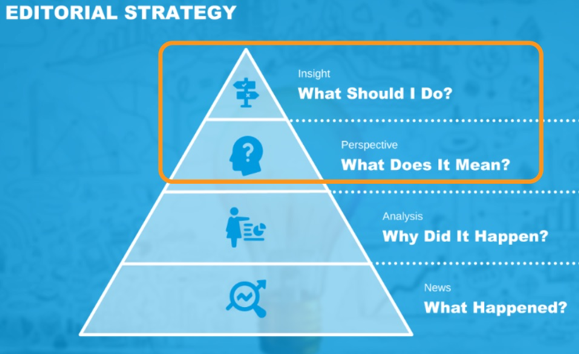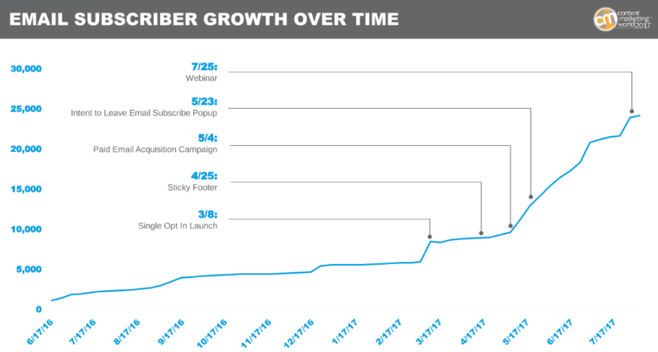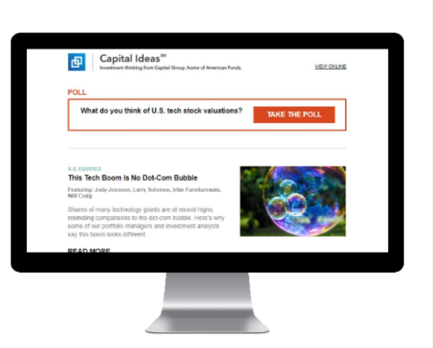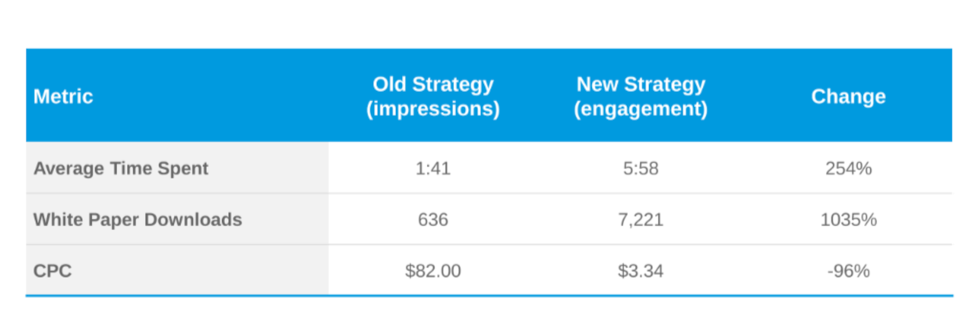“It’s 2018. We can’t hoard knowledge any longer.” Andy Crestodina, speaker, blogger, etc., shared that nugget of wisdom at the recent Intelligent Content Conference in Las Vegas.
If you need proof of how true his observation is, look no further than the Capital Group, a conservative, trusted financial services company that – until recently – lagged far behind its competitors in thought leadership and digital marketing.
“We were hiding our light under a bushel,” says Will McKenna, describing the company’s marketing efforts in the talk he and Fred Macri gave at Content Marketing World 2017: Awakening a Sleeping Giant: Crafting a Successful Content Brand in an 86-Year-Old Enterprise.
“Our marketing was immature,” Will says. Meanwhile, their competitors had become, as Will describes, “very visible, very good at this. They’re out on CNBC. They’re out on the digital space. The world had kind of passed us by.”
The Capital Group, which manages $1.7 trillion in assets, had amassed many loyal financial services advisors as clients. Yet it risked losing market share to competitors that more openly shared insights on news that affects investment decisions.
Fred and Will tried something to catch up to – and even leapfrog – competitors. Their idea? Create a content brand: Capital Ideas.
Launching a content brand is one thing. Making it a success is another. Capital Group succeeded because it positioned its content to provide answers its audience is hungry for – answers it’s uniquely capable of providing.
Capital Group’s content answers audience questions it’s uniquely capable of answering, says @MarciaRJohnston.
Click To Tweet
Fred and Will’s story offers many takeaways for anyone launching a new content initiative.
- Ask (and answer) why a content brand makes sense.
- Choose the content you will (and won’t) focus on.
- Stay plugged in to audience needs.
- Invest in your email newsletter.
- Find internal supporters to help promote the content.
- Recognize that paid content promotion pays off.
1. Ask (and answer) why a content brand makes sense
When you set out to create a new content brand, identify what problem it solves for your company. Capital Group, for example, wanted to solve the problem of being “quiet and slow to act.”
Will, a senior creative manager at American Funds, part of Capital Group, knew in their business, “thought leadership is not just kind of nice, something extra. It’s critical.”
Thought leadership is not just kind of nice, something extra. It's critical. @marciarjohnston
Click To Tweet
Those in Capital Group’s audience – the total addressable market comprises 250,000 financial advisors in the United States – spend their day on the phone with clients who want to know what’s going on out in the investment environment. They have questions like, “What impact does all the geopolitical turmoil have on my portfolio?”
Customers were eager to hear what Capital Group had to say. And the firm was full of investment professionals around the world – 300 or so – looking at stocks all day and coming up with insights.
“We saw that we could use content marketing to engage our audience,” says Fred, who heads content marketing at Capital Group.
Capital Ideas gave the company a thought-leadership platform as well as fuel for the company’s paid, earned, and owned media initiatives. Today, Fred shares, Capital Ideas provides 60% of the content the company uses across social media, native advertising, and paid content distribution.
2. Choose the content you will (and won’t) focus on
After you identify the business problem that justifies your content brand, decide how to deliver “overwhelming value” to your audience on that platform. In other words, choose the content that you will (and won’t) focus on.
Since Capital Group is built on long-term investing, Capital Ideas focuses on long-term considerations related to events in the news. That means not focusing on the immediate news (what happened?) or the analysis of news (why did it happen?) at the bottom of this pyramid. Instead, Capital focuses on delivering perspective (what does it mean?) and insight (what should I do?) at the top.
Fred gives an example of the Brexit news coverage. Bloomberg printed daily news stories (what had happened) and The Wall Street Journal provided deeper analysis (why it had happened).
“We’re not going to compete with Bloomberg and The Wall Street Journal,” Fred says. “We’re going to talk about what Brexit means to investors and what financial advisors should tell their clients.”
HANDPICKED RELATED CONTENT:
3. Stay plugged in to audience needs
How do you find out what your audience wants to know? Here are some things the content team at Capital Group does:
- Conduct polls on Capital Ideas site.
- Track analytics to see how their audience responds to their content.
- Hold webinars (attended by thousands of advisors) that give the company’s take on the investment landscape – and conduct polls there, too.
To find out what your audience wants to know, conduct a poll on your website. @marciarjohnston
Click To Tweet
The team then creates articles accordingly. For example, a webinar attendee said, “Many of my clients want to get out of global stocks. Their global funds are down, and they don’t want to buy more. I’ve explained the benefits of diversification, but logic isn’t working. What else can I tell them?”
In response, the Capital Ideas team published the answer in what became their top opt-in article.
“You have to find ways to stay plugged in to your audience,” Will says. “Find out their questions and issues and address them. People will come to see you as a resource.”
Find out questions & issues your audience has & address them. @marciarjohnston #contentmarketing
Click To Tweet
HANDPICKED RELATED CONTENT:
4. Invest in your email newsletter
The Capital Group puts love (aka time and energy) into its Friday email newsletters – and it has over 30,000 subscribers to show for that love. And they’re headed toward their goal of 100,000.
This chart shows the subscriber growth from various sources during the 12 months leading up to July 2017.
The newsletter has been a big win for the company, garnering an open rate double of the American Funds Insights newsletter, another Capital Group offering. Even better? It gives Capital Group a reason to connect with its best customers weekly, people who otherwise might talk to a Capital Group representative once a quarter.
Will says there’s no big silver bullet that worked for the newsletter. Instead, he credits small improvements over time, such as:
- A switch to a single opt-in from a double opt-in
- A sticky footer on the site to make the subscription option easy to see
- An intent-to-leave pop-up that avoids interrupting readers while they’re engaged but shows up with the subscription offer before they navigate away
Then, of course, there’s the content. Every Friday, the Capital Ideas newsletter offers a curated list of the site’s best content plus some extra insights.
“It’s very convenient for advisors,” Will says. “It gets them on a day when they’re reflecting back on the week and thinking of the week ahead.”
The takeaway: If you’re going to launch a newsletter as part of a content brand, be prepared to invest enough time and energy – over and over – to make it outstanding.
If you’re going to launch a newsletter as part of a content brand, make it outstanding. @marciarjohnston
Click To Tweet
5. Find internal supporters to help promote this content
To get your message out, there’s nothing wrong with tapping in to external audiences, including influencers. But don’t forget to also tap in to employees. “Amplify from the inside out,” Fred says.
For example, to entice Capital Group sales employees to participate, Will and Fred’s team created challenges: Who can get to a hundred subscribers first? Who can get a hundred advisors in your territory to sign up by the end of the year?
“These are busy people with mutual funds to sell. They’re not sitting around waiting to be asked to do something extra,” Fred says. “We appealed to their sense of competition and fun.”
In addition, the salespeople want to help the content platform succeed because the content platform helps them succeed. “They’re out there calling on Merrill Lynch advisors, going into these offices,” Fred says. “They need a reason to call and something smart to say. Our articles give them that.”
To make the platform even more useful to Capital Group employees, the team designed the site in formats easily displayed on a screen for presentations.
Fred’s advice: Think deeply about who your internal proponents could be. Create relationships throughout the company.
HANDPICKED RELATED CONTENT:
6. Recognize that paid content promotion pays off
Fred calls impression stats “the biggest lie in marketing.” That’s no surprise to anyone who’s familiar with content marketing. Instead of promotions based on banner ads, Capital Ideas relies on paid social promotion, mostly on Twitter and LinkedIn because that’s where the audience is.
To round out the promotion strategy, the team invests in content syndication through Dianomi, which focuses on financial services content, and tested Taboola and other services.
Use tools like @dianomi & @taboola for #content syndication. Read more >>
Click To Tweet
But the bulk of the content promotion budget rests in social. Why? “When you move from impressions to engagement,” Fred says, “you get these bonus actions on social like ‘likes,’ retweets, comments, that you’re not paying for.”
The results prove his point. “When you don’t buy live impressions, you see growth. People want to engage in content. They want something that’s interesting. And so you get a thousand percent increase in white-paper downloads. Time spent increases by 250%. Cost per click goes down almost 100%. That’s been heartening to see.”
Conclusion
If your brand needs re-energizing, consider creating a content brand, as Fred and Will’s Capital Ideas team did. When you do, or when you optimize existing content initiatives, see what you can learn from the Capital approach.
If you have a content brand, how has it helped turbocharge your marketing?
Please note: All tools included in our blog posts are suggested by authors, not the CMI editorial team. No one post can provide all relevant tools in the space. Feel free to include additional tools in the comments (from your company or ones that you have used).
Learn more firsthand success stories to inspire and inform your content marketing programs. Register today for Content Marketing World Sept. 4-7. Use code BLOG100 to save $100.
Cover image by Joseph Kalinowski/Content Marketing Institute
The post Falling Behind Your Competitors? Build a Content Brand appeared first on Content Marketing Institute.









No comments:
Post a Comment